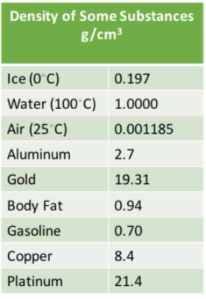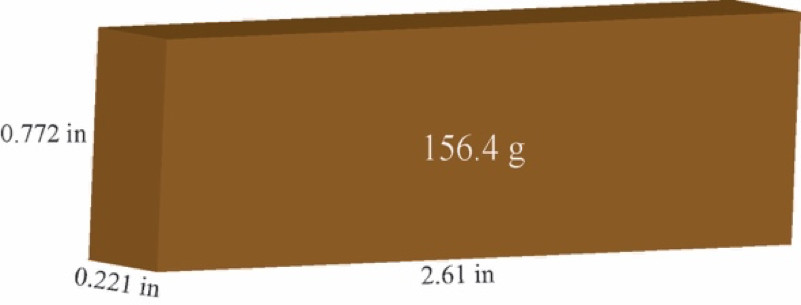Up to this point, we have learned how convert from unit of measurement to another within the same types of units of measurement. For example, converting seconds, s, to microseconds, s we are in units of time. Converting milliliters, mL, to nanoliters, nL we are in units of volume. But it is possible covert from one unit of measurement, for example distance, to a completely different unit of measurement, for example time. In another situation, we can interconvert between mass and volume. How is this possible? Consider driving a car at 35 miles per hour, 35 mph. If you drive at this velocity for 2 hours, you can determine the distance you will travel in that time, 70 miles. In other words, with velocity we can interconvert between distance and time. It may not be apparent at first, but 35 miles per hour can written as the conversion factor,
As we know distance and time are totally different units, but they become related through a velocity. Another example of this is density, which is an indication of the mass of atoms, molecules, or ions within a unit of volume. Density is defined as the mass of a substance per unit volume.
For example, gold has a density of 19.31 g/cm3. This means that 1 cm3 of gold has a mass of 19.30 g. On the other hand, lithium, a much lighter substance, has a density of only 0.534 g/cm3. Just as velocity interrelates distance and time, density allows us to interconvert between mass and volume. As we did with velocity, let’s look at the density of gold as a conversion factor.
For example to find the mass of 4.50 cm3 of gold we use the conversion factor on the right to cancel out cm3.
Density is a physical property of a substance and is useful in determining the identity of unknown substances. For solids, the volumes are stated in cm3, for liquids, the volumes are stated in mL, and for gases, the volumes are states in L. Recall, 1 cm3 is equivalent to 1 mL. Most substances will change in volume when heated or cooled making density temperature dependent. Water, at 3.98 oC, has a density of 1.0000 g/mL. This is because at 3.98 oC, a 1.0000 mL container will hold exactly 1.0000 g of water. At a temperature of 100.00 oC, the volume that is occupied by the water expands. The 1.0000 mL container can only hold 0.9584 g of water making its density at 100.00oC, 0.9584 g/mL. Temperature should be specified when reporting density.
Most substances expand when they are heated and they contract when cooled. Water is an exception–it contracts when cooled from 100oC to 3.98oC and will expand once below 3.98oC. The density of liquid water is at a maximum of 1.0000 g/mL at 3.98oC and decreases to 0.9987 g/mL at 0oC. Any substance, including ice, with a density less than liquid water will float. A substance with density greater than that of liquid water will sink.
 If the mass and the density is known, we can determine the volume required. If we know the volume and the density, we can determine the mass of the substance. We can better understand the practical application of densities by doing examples followed by exercises.
If the mass and the density is known, we can determine the volume required. If we know the volume and the density, we can determine the mass of the substance. We can better understand the practical application of densities by doing examples followed by exercises.
A cube of copper has a volume of 12.2 cm3. If the mass of the cube is 109 g, what is the density of the copper? We know that density is mass per unit volume. In the case of the cube, we are given both the volume and the mass.
In another example, we ask what is the mass of 11.6 cm3 of gold. Gold has a density of 19.31 g/cm3. We know both the density and the volume of the gold. We must solve for the mass.
Mercury, the only metal that exists as a liquid, has a density of 13.55 g/mL. Let’s calculate the volume of 0.025 kg of mercury. This time we need to solve the density formula for volume.
Notice the mass is given in kg. We need to convert it to grams. We know that 0.025 kg of mercury is equivalent to 25 g of mercury.
Click Here for Density: A Derived Unit Worksheet
Worksheet: Density and Energy
Videos: Density
Density Problems (2 problems)
Volume Conversion
Exercises
1. A student needs 5.85 g of liquid ethanol for an experiment. Ethanol has a density of 0.789 g/mL. What volume, in mL, will the student measure?
Check Answer and/or View Worked Out Solution
2. Fill in the following table. Use the density table above to identify the substances.

Check Answer and/or View Worked Out Solution
3. Calculate the density of the metal bar in g/cm3.
Check Answer and/or View Worked Out Solution
4. Iron melts at 1,538 oC at which point its density is 6.98 g/cm3. At that temperature what would be the volume, in cubic centimeters, of 2.86 kg of liquid iron?
Check Answer and/or View Worked Out Solution
Back to Study Guide List for General Chemistry I
Go To Home Page
